Слайд 2Definitions
Communication - the process by which people convey and receive information

to and from each other
Decision making - a process of selecting a particular course of action from among the options available
Problem solving - the activity of generating a solution to a recognized problem
Слайд 3A model of communication
Figure 8.1

Слайд 4Human communication
Figure 8.2

Слайд 5Human communication within organizations
Figure 8.3

Слайд 6The two dimensions of communications
Figure 8.4

Слайд 7Increasing number and complexity of communication linkages

Слайд 8Communications within organizations
Communications in large organizations needs to be managed carefully:
Limitation
Procedure

Teamwork
Automation
Separation
Jargon
Слайд 9Communications processes
Communication - four general functions:
Information processing
Co-ordination
Visioning
Personal expression
Methods

of communication:
Written
Oral
Non-verbal
Electronic
Слайд 10The manager’s communication network
Figure 8.6

Слайд 11Seating arrangements for effect
Figure 8.7

Слайд 12Non-verbal communications
Table 8.2

Слайд 14Guidelines for providing effective interpersonal feedback
Table 8.4
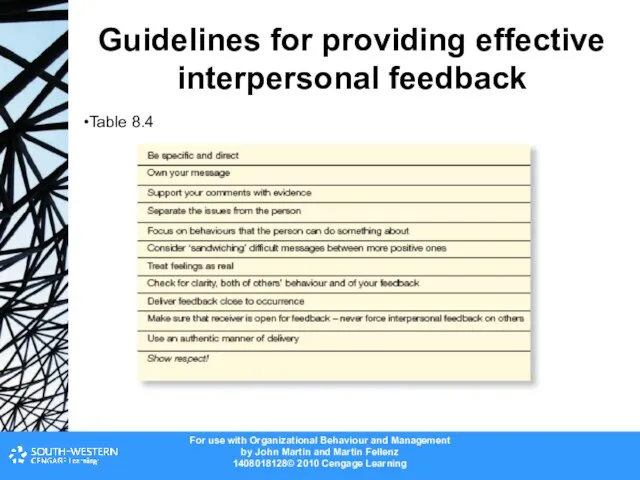
Слайд 15Guidelines for receiving interpersonal feedback
Table 8.5
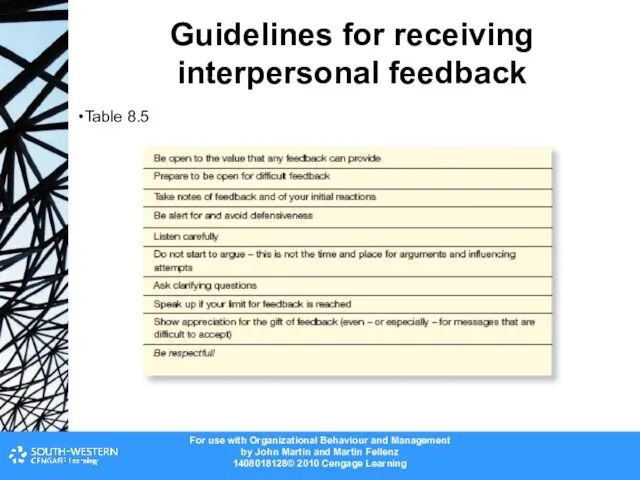
Слайд 16The Johari Window and the processes for increasing awareness (1)
Figure 8.8a
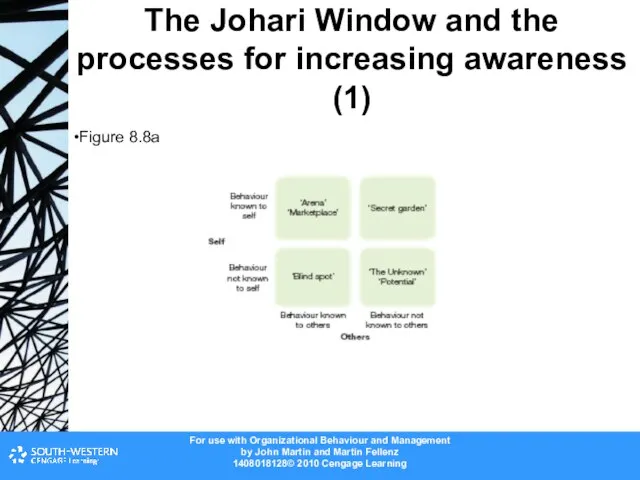
Слайд 17The Johari Window and the processes for increasing awareness (2)
Figure 8.8b
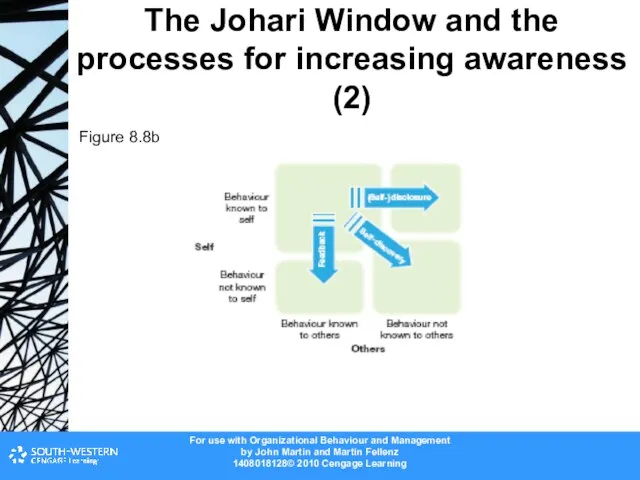
Слайд 18Factors influencing decision processes and outcomes
Figure 8.9
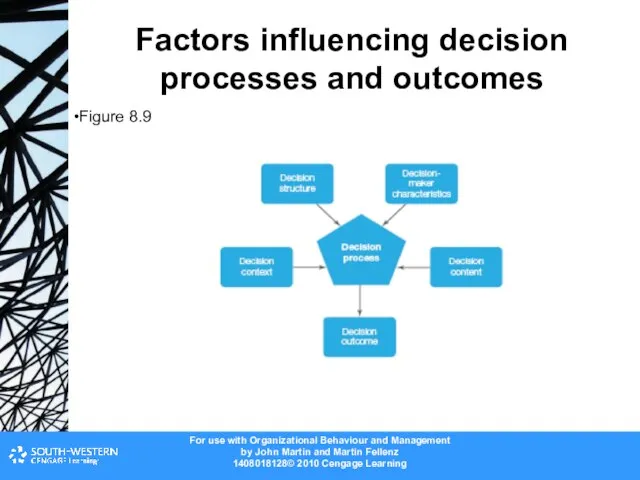
Слайд 19Decision making models
Programmed and non-programmed decision making
Rational model
Bounded rationality
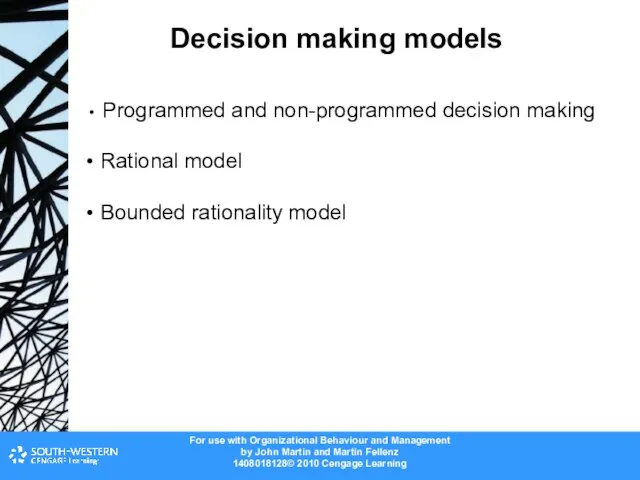
model
Слайд 20Heuristics
Heuristics refer to mental shortcuts or cognitive ‘rules of thumb’
Judgemental heuristics, biases
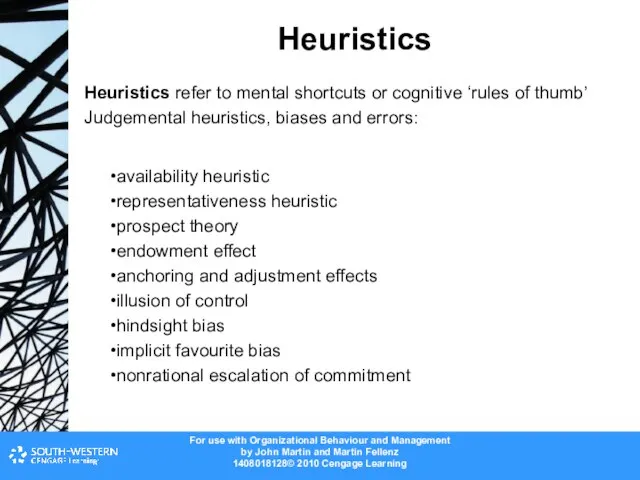
and errors:
availability heuristic
representativeness heuristic
prospect theory
endowment effect
anchoring and adjustment effects
illusion of control
hindsight bias
implicit favourite bias
nonrational escalation of commitment
Слайд 21Group-level decision making
Concordet Jury Theorem
Concordet’s Paradox
Group polarization (risky shift phenomenon)
Groupthink
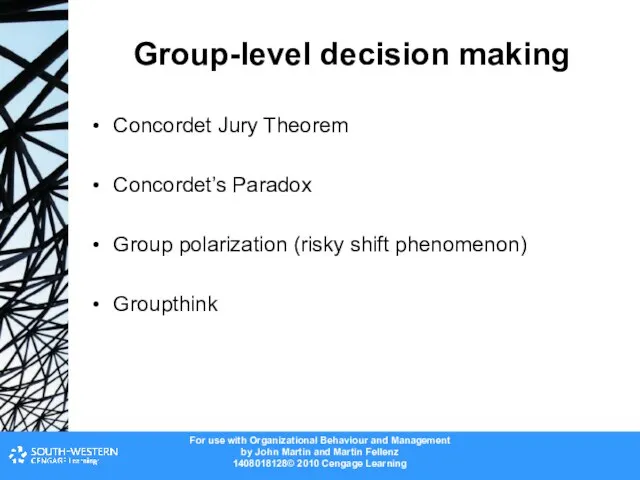
Слайд 23Preventing groupthink
Figure 8.10
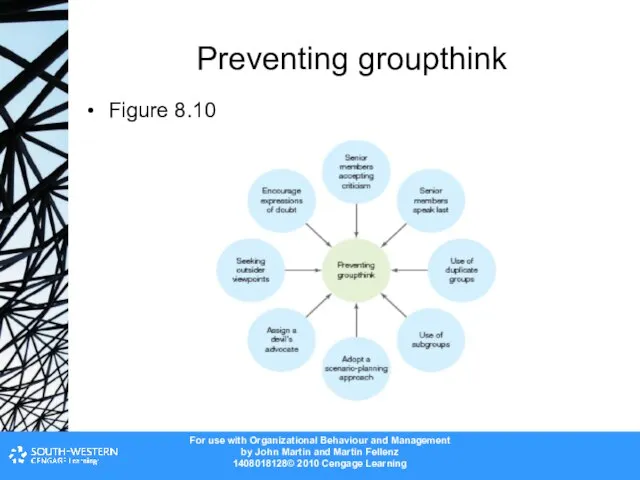
Слайд 24Improving decision making within groups and teams
Janis (1982, 1989; Janis & Mann,
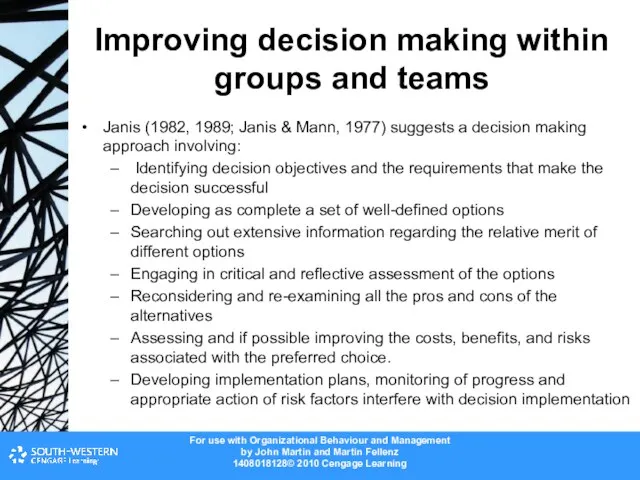
1977) suggests a decision making approach involving:
Identifying decision objectives and the requirements that make the decision successful
Developing as complete a set of well-defined options
Searching out extensive information regarding the relative merit of different options
Engaging in critical and reflective assessment of the options
Reconsidering and re-examining all the pros and cons of the alternatives
Assessing and if possible improving the costs, benefits, and risks associated with the preferred choice.
Developing implementation plans, monitoring of progress and appropriate action of risk factors interfere with decision implementation
Слайд 25Improving decision making within groups and teams
Devil’s advocate
Dialectical Inquiry
Reflexivity
Production
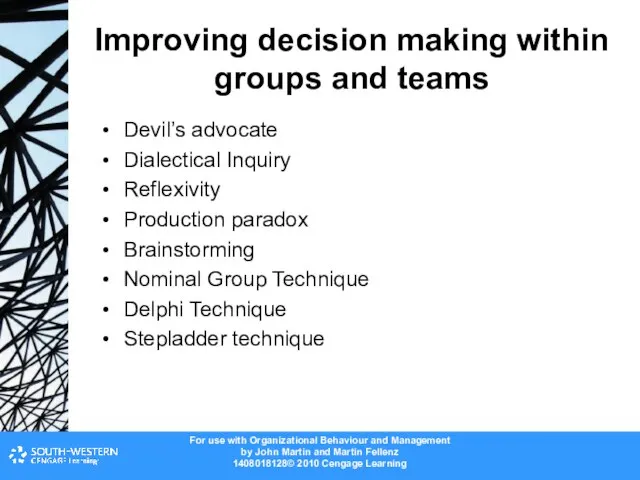
paradox
Brainstorming
Nominal Group Technique
Delphi Technique
Stepladder technique
Слайд 26Models of organizational decision making
Management science model
Carnegie Model
Incremental Decision Making
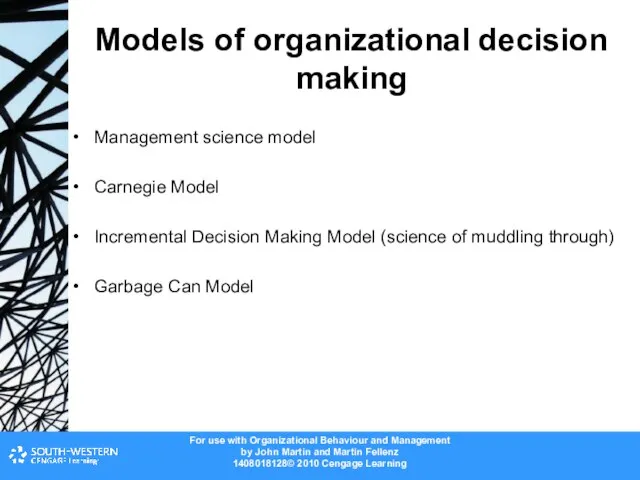
Model (science of muddling through)
Garbage Can Model
Слайд 27Daft’s Contingency Framework for Using Decision Models
Figure 8.11
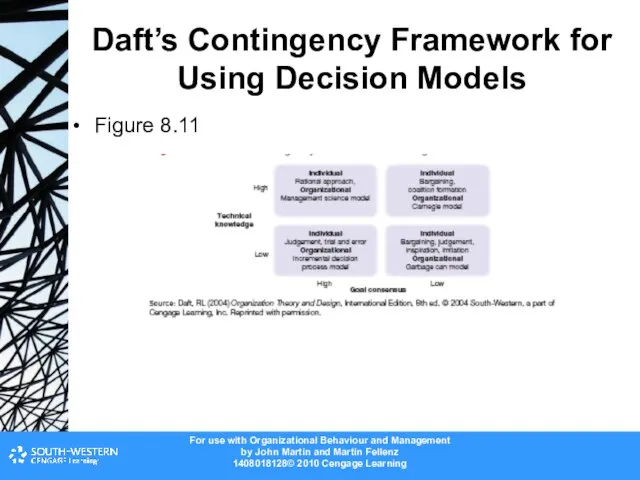











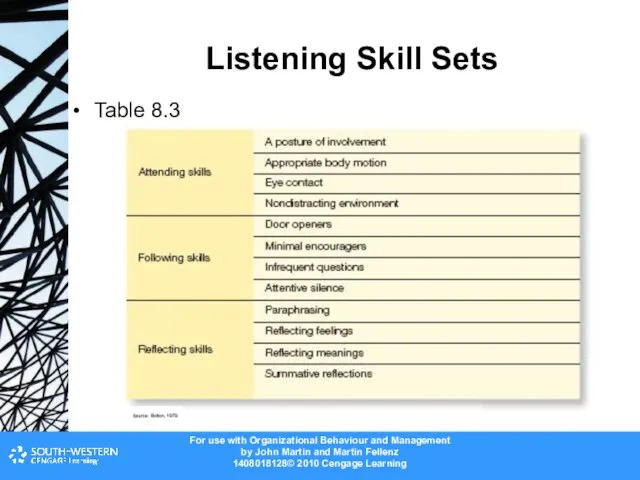








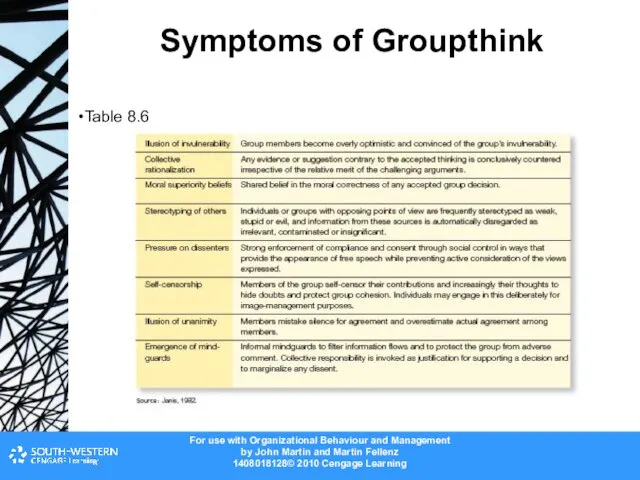





 Использование энергии движущейся воды и ветра
Использование энергии движущейся воды и ветра Увлечение вязание
Увлечение вязание О компании
О компании Реклама на Радио
Реклама на Радио Шанхай
Шанхай Банковская система Люксембурга
Банковская система Люксембурга Magnivico. Система диагностики производства искусственным интеллектом
Magnivico. Система диагностики производства искусственным интеллектом Презентация на тему Игромания. Зависимость от игр
Презентация на тему Игромания. Зависимость от игр Биологическая роль элементов 3,4 групп-1
Биологическая роль элементов 3,4 групп-1 Размножение организмов
Размножение организмов Christmas in Great Britain
Christmas in Great Britain Развитие специализированных магазинов на розничном рынке, мировой опыт
Развитие специализированных магазинов на розничном рынке, мировой опыт Крестьянство повседневный быт и обычаи
Крестьянство повседневный быт и обычаи Презентация на тему "Современный урок - Основная форма процесса обучения" - скачать презентации по Педагогике
Презентация на тему "Современный урок - Основная форма процесса обучения" - скачать презентации по Педагогике Презентация на тему Улица и ее знаки
Презентация на тему Улица и ее знаки  Чем питаются животные?
Чем питаются животные? Самовыражение в цвете
Самовыражение в цвете Троекуровский Свято – Димитриевский Иларионовский женский монастырь
Троекуровский Свято – Димитриевский Иларионовский женский монастырь Развитие творческих способностей учащихся
Развитие творческих способностей учащихся Классный час, посвященный выбору профессий
Классный час, посвященный выбору профессий МБОУ СОШ № 2
МБОУ СОШ № 2 Принципы, методы и этика исследований личности
Принципы, методы и этика исследований личности Презентация на тему Крохали
Презентация на тему Крохали «Облачный» сервис Bitrix24: социальный интранет
«Облачный» сервис Bitrix24: социальный интранет Что изучает курс «География материков и океанов»
Что изучает курс «География материков и океанов» Угадай фильм с Винни-пухом
Угадай фильм с Винни-пухом Качество товара. Товарный ассортимент. Товарная номенклатура
Качество товара. Товарный ассортимент. Товарная номенклатура Многофакторная модель Хеллера (Мюнхенская модель одаренности)
Многофакторная модель Хеллера (Мюнхенская модель одаренности)